For many of us, being told to stand or sit up straight is something that we hear from an early age. Even adults struggle to maintain good posture for long periods. The human body is very adaptable and in an age of long commutes to work, working at a desk, many hours at school, or carrying heavy children and not lifting properly, our body can become accustomed to some poor positioning over time. Building better posture is a reasonable goal to work towards at any age! With awareness, changing habits, stretching, exercise, and patience, improved posture can be accomplished.
Although becoming aware of poor posture hardly fosters a sense of self-confidence, it is the first step in making real change. Perhaps your loved ones or coworkers mentioned something about you hunching over. If frequent headaches, painful upper or mid back, or tense shoulders plague you, consider having someone take your picture from a side view. If your neck is flexed forward, shoulders raised towards your ears, and upper back rounded or hunched…it is time to make real changes.
Changing daily habits is an important step to take. If a large majority of your day is spent sitting at a desk, being sure you have proper positioning and low back support is key.
Good Desk Ergonomics:
- Ears are aligned with tops of shoulders.
- Shoulders should be relaxed, not elevated.
- If you regularly use a phone, it is held upright and not with bent neck when in use.
- Consider a headset if a phone is used frequently throughout your shift.
- 90-120 degree bend in the elbow with minimal bend in the wrist.
- A cushion is supporting your lower back.
- Hip angle is 90-120 degrees.
- Pressure is distributed equally on bottom and thighs.
- Back of the knees don’t touch the edge of the seat and are at a 90-120 degree bend.
- Feet are flat or on a slightly inclined footrest.
As a student or anyone who goes on backpacking trips, your pack or bag should not weight more than 20 percent of your total body weight. Lifting, reaching, and carrying objects should be done correctly to protect your back health.
Correct Lifting and Carrying:
- Stand close to object
- Test the weight
- If too heavy, ask for help
- If too low for you to comfortably pick up, ask for help or get a dolly
- Bent at the hips and knees
- Keep your back straight
- Hold object close to your body
- Pivot with your feet to change direction
- Do not twist your trunk to turn with a heavy object in your hands
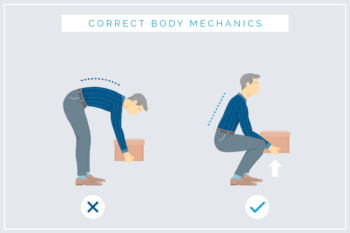
Stretching is crucial to opening the chest, relaxing shoulders, and getting more movement in your upper back. Working with arms extended out before you puts your chest muscles in a shortened position, which can pull shoulders forward and round your spine. Stretches should not be painful! If they are, move out of the stretch until you find a comfortable position.
Stretches to Improve Posture:
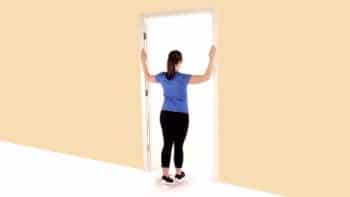
Place bent elbows on a door frame and slowly walk forward until you feel a stretch across your chest and the front of shoulders. Hold 15-20 seconds, perform 1-2 times a day.
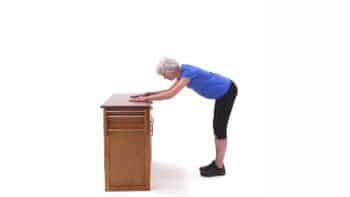
Stand a few feet from a counter/desk, placing hands flat, and lean forward with a flat back. A stretch should be felt in your back or back of the legs. Hold 15-20 seconds, perform 1-2 times a day.
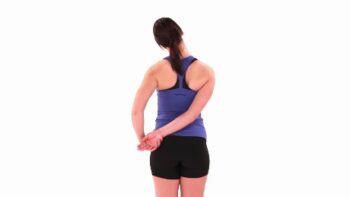
While standing or sitting, grab your wrist and move ear to opposite shoulder, feeling a stretch from below your ear to the top of your shoulder. Hold 15-20 seconds, perform both sides 1-2 times a day.

While sitting or standing, turn head and look down (you should feel at the back of neck). Hold 15-20 seconds, perform both sides 1-2 times a day.
After stretching, working to strengthen muscles to hold you up in good posture should be a focus.
Strengthening to Improve Posture:

Shoulder rows with a band anchored in front. Anchor the band on a bed frame, table leg, or sink faucet and do sitting or standing. 10-15 reps 1-2 times/day.
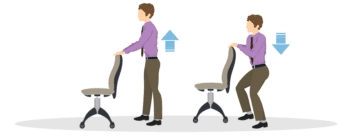
Mini squats with chair support (or desk/counter) help to strengthen hips and glutes. Knees should not move forward of your toes. Keep back flat and reach your bottom back. 10-15 reps 1-2 times/day.
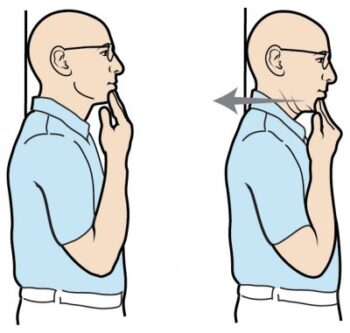
Move chin straight back and slight nod down. 5 reps, holding for 5 seconds 1-2 times/day.
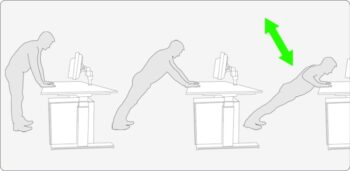
Counter/desk push ups to strengthen your core and back. 10-15 reps 1-2 times/day. If this is very difficult, reduce the angle your body is at.
If there is any pain with these stretches or exercises or if you are experiencing numbness, tingling, or any worrying symptoms, please schedule a free consultation with our staff chiropractors or physical therapist. Be kind to yourself, as noticeable changes can take time. Remember, your physical well-being is very important.





